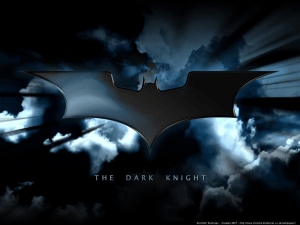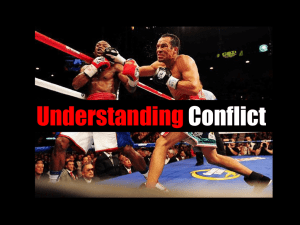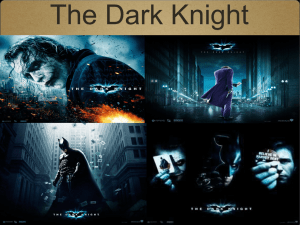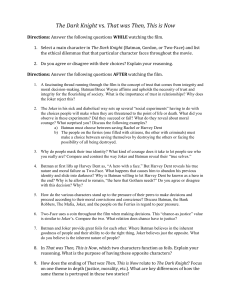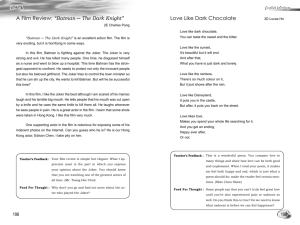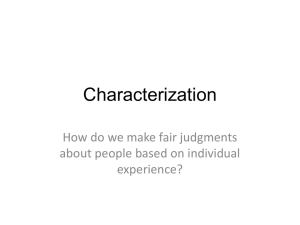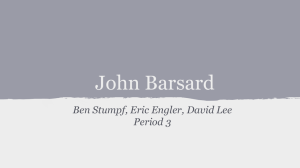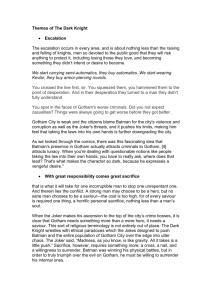Foucault and The Dark Knight
advertisement
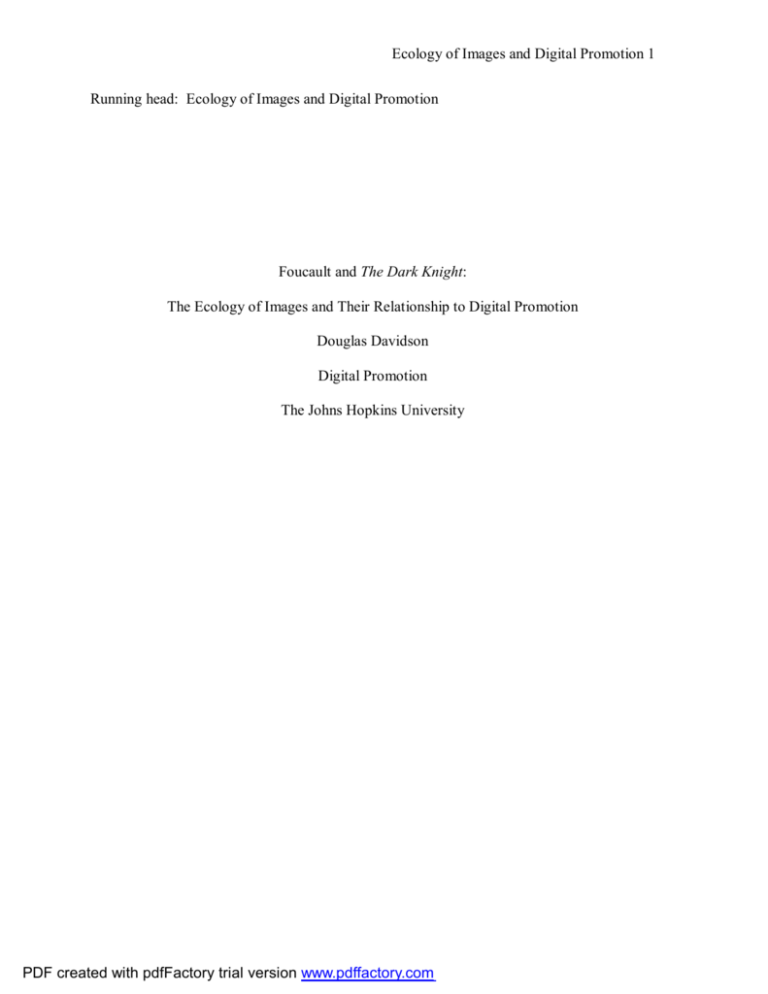
Ecology of Images and Digital Promotion 1 Running head: Ecology of Images and Digital Promotion Foucault and The Dark Knight: The Ecology of Images and Their Relationship to Digital Promotion Douglas Davidson Digital Promotion The Johns Hopkins University PDF created with pdfFactory trial version www.pdffactory.com Ecology of Images and Digital Promotion 2 Abstract Traditional forms of promotion (radio, television, print) no longer possess the strength alone to acquire an audience’s attention. Introducing digital media as part of a promotional campaign invites the audience to take part in the campaign differently from traditional media and allows an audience to achieve an increased connection to the material. An examination of the digital promotional campaign for the July 2008 release of The Dark Knight via an alternate reality game (ARG) was conducted to review the use of digital, traditional, and realworld promotional techniques. PDF created with pdfFactory trial version www.pdffactory.com Ecology of Images and Digital Promotion 3 Introduction Before words, images were the language of the world. Images were the visual representations of objects. The meanings images hold depend on the individual reviewing them. Noted historian of technology and science, Lewis Mumford said that “art is the reenactment of reality” (1934). The birth of art is not from the machinations of technology, but from the inspiration of the natural world. Cultural theorist Jean Baudrillard claimed that reality didn’t exist at all, but that the images we see are the simulacra of a hyperreality in which no true reality exists (1994). In other words, the world we know is merely the copy of a copy of a copy of a copy leaving no trace of an original work. Michel Foucault, however, had a different approach to the images of the world. He believed that images are the sum of the world – the language by which we communicate and tell the story of our lives (1994). Foucault believed that there was an order to the things in the world and that language, specifically, was a representation of the images ingrained in society (1994). That resemblance in nature to human physiology was not by accident. That the human body mirrored the nature world with its veins like rivers, bones as rocks, and flesh as the earth itself. That a walnut, shaped like the human brain, when mixed with wine could cure headaches. Or that language was born by assigning significance to images and assigning meaning. Though language and its meaning varied depending on your location, the images all around remained the same due to their simplicity in nature. These images are the basis for universal discourse and the forefather to digital communication. The world we live in today is composed of images on screens which seek to tell stories, revealing their meaning. Before the emergence of digital communication, story telling via promotional material functioned within in different paradigm. At first, print held the attention of the PDF created with pdfFactory trial version www.pdffactory.com Ecology of Images and Digital Promotion 4 world. Then the discovery of wave-delivered messages gave birth to the radio and then television. Known as traditional media today, these media tools became the go-to for any individual or business that sought a message-delivery system. With the boom of digital communication through the internet, companies no longer needed to promote themselves using the one-to-many messaging paradigm, hoping that someone may understand their message. Instead, the digital world granted access to one-to-one communication ensuring that the messages sent out reach the desired audience. With this change to the one-to-one messaging paradigm, the tools of promotions changed as well. Digital promotions utilize video, images and sound via the internet to interact with an audience to tell a story. Utilizing jpegs, flash files, and mp3s hidden in plain sight throughout the web, promotions teams seek to promote without promotion. Instead, interaction is the goal. Interaction breeds interest which can result in an emotional response and greater interest. A new form of promotion, Alternate Reality Games (ARGs) are planted with little fan-fare in the world wide web and lie in wait for someone to find them. Typically, there is nothing to win, only knowledge to gain and it usually requires more than one person to figure out the game. Like bees in a hive working together to take care of the queen, ARGs use the collective intelligence of the world to tell a story and sell you on an idea. In early 2007, a website baring the likeness of actor Aaron Eckhart appeared online featuring a url made from the message going with the image – I Believe In Harvey Dent. No announcement, no press release. The image of the actor linked to the name Harvey Dent meant something to the comic book collective who began seeking out further information. More websites began to appear, some with clear directions and others with puzzles that had to be solved before more directions could be revealed. It was a game to be played until the PDF created with pdfFactory trial version www.pdffactory.com Ecology of Images and Digital Promotion 5 release of the film, The Dark Knight, in the summer of 2008. Participants did not know where the game would take them or what it would ask, but from all over the world they followed. Foucault said that images are the language of the world, given meaning by each individual. Symbols that explain the order of things in nature, in our humanity. Through an examination of The Dark Knight ARG, the importance of meaning in images and language via digital promotion may be revealed. The Dark Knight Promotional Campaign The following will describe the premise and execution of the viral campaign that ran from the beginning of May, 2007 and ending the week of July 18th, 2008 in support of the cinematic release of The Dark Knight. Premise The Dark Knight promotional campaign bridged the gap between the end of the first film, Batman Begins, and the start of the The Dark Knight. At the end of the first film, Batman won an ally in Lt. Gordon and A.D.A. Rachel Dawes and was introduced to the existence of a man who left joker playing cards at the scene of his crimes. The promotional campaign introduced the characters of the district attorney hopeful Harvey Dent and the chaotic, charismatic Joker. Throughout the promotion, Harvey Dent pursued the district attorney office, complete with campaign stops throughout the United States, while the Joker recruited by leaving tasks for members of the general populace to undertake. Everything in the promotional campaign culminated in a bank heist by the Joker which acted as the opening scene of the film, The Dark Knight, bridging the virtual world of the promotional campaign with the cinematic world of the film. PDF created with pdfFactory trial version www.pdffactory.com Ecology of Images and Digital Promotion 6 Execution The following is a summation of the activities members of the Dark Knight collective undertook as found on the website whysoserious.com through the promotion designed by immersive entertainment company 42 Entertainment in conjunction with Warner Brothers. Beginning in early 2007, a website featuring Aaron Eckart as DC Comics character Harvey Dent, appeared online under the url www.ibelieveinharveydent.com (N.A, 2008a). The url was taken from a line spoken by Bruce Wayne in the comic series The Long Halloween which saw the birth of Harvey’s villainous alter-ego Two-Face. This reference provided fans of the Batman comic series with a hint that more was to come. On May 19th, 2007, joker cards appeared in comic book stores with the handwritten “I Believe In Harvey Dent too” leading to a defaced version of the previously released website. These images introduced visitors to the featured characters of the story – Harvey Dent and the Joker. Through the Jokerized Harvey Dent site, the Joker requested e-mail addresses to build his gang with new members. By May 20th, 2007, the defaced Dent was replaced by the first image of the Joker, which was then removed less than a day later to be replaced by a hidden message. At first, the website only shown a “Page not found” message, but after highlighting the entire page, the real message was revealed – ha ha – over and over again. Hidden between the H’s and A’s was another hidden message, “See you in December.” The next message would come two months later during the 2007 Comic-Con International: San Diego. Amid all the comic book festivities and grand announcements at the ComicCon, attendees found defaced one dollar bills and another website to review – whysoserious.com PDF created with pdfFactory trial version www.pdffactory.com Ecology of Images and Digital Promotion 7 (N.A., 2008b). This site informed visitors where and when they needed to be if they wanted to join the Joker’s gang. At the location, “new recruits” partnered with someone at a computer were given the task of answering questions and finding secret locations before being made up in Joker-face as a member of his crew. All new recruits who completed the trials became henchmen and had their mug shot taken. One henchman pretended to be the Joker when the “cops” arrived and took the fall for all of the day’s activities. This “patsy” also provided a body with which to fake the “death” of the Joker to throw off the “Gotham City Police Department” that were patrolling the area. After his “death”, the Joker went quiet until Halloween. For a while, after the July incident, the whysoserious.com page was replaced by renta-clown.com, featuring many of the henchmen who participated in the Comic-Con event. On October 17th, 2007, however, the site transformed again to reveal a carved pumpkin with a burning candle and a bat for a mouth (N.A., 2008c). The closer to Halloween, the farther down the candle burned until it was out and the pumpkin began to rot. Only one side of the pumpkin’s face began to decay, however, while the other side stayed healthy and normal. At midnight, on November 1st, 2007, the pumpkin changed to a list of cities in the United States and directions for the next task. Photos were to be taken at specific locations and uploaded as soon as possible. Once assembled, the pictures revealed a message which then burned away revealing another photo of the Joker, as well as another mission. This time the call went out to PDF created with pdfFactory trial version www.pdffactory.com Ecology of Images and Digital Promotion 8 henchmen around the world to post photos of themselves in front of famous monuments. The Joker requested that the groups be large and all wearing his famous face. On November 21st, 2007, anyone who submitted their photos received a hard copy of Gotham City’s newspaper “The Gotham Times,” while a Jokerized version, simply called, “The Ha Ha Ha Times”, appeared online days later. Breaking for Thanksgiving, the Joker would send another message to his willing henchmen early December 2007. On December 3rd, 2007, the Joker started a new game requiring participants to race to specific pastry shops across the country and to use the name “Robin Banks” upon arrival (N.A., 2008d). With this alias, each henchmen was given a cake, with gifts from the Joker inside – a joker card, a cell phone, a charger, and a note with instructions. The fastest henchmen in the selected cities now possessed a direct connection to the Joker and were required to keep the phone on and charged at all times. The phone later acted as a pass to a screening of footage of The Dark Knight that was included with the trailers of the IMAX release of I Am Legend in December 2007. The Joker would not appear again until April 2008, but left the present of a new trailer for The Dark Knight prior to the holidays for his loyal henchmen. On April Fool’s Day, a website for Clown Travel Agency appeared and provided coordinates for locations around the world for another special mission (N.A., 2008e). While the last mission sent henchmen to a bakery, the new one sent them bowling. Armed with addresses, locker numbers and combinations, the fastest in each of the 26 cities received a PDF created with pdfFactory trial version www.pdffactory.com Ecology of Images and Digital Promotion 9 green and purple bowling ball, cell phone, joker card, and ball bag with a phone number engraving. The next mission sent all willing henchmen, not just those with the phones, to hack the voice recognition security system for Acme Security Systems. The phones and Acme website, however, had been tapped by the Gotham City Major Crimes Unit, so each user was trapped by Lieutenant Jim Gordan and forced to become a criminal informant (CI). Each CI was then tasked with intercepting a package meant for a known mobster associate. Upon successful completion, CIs were released with the charges of security hacking dropped. Later in the month of April, the Joker unveiled one final real-world mission. Portraits of Jokerized American Presidents contained information of locations in twelve cities around the world (N.A., 2008f). Each portrait featured latitude and longitude coordinates and a countdown clock. Once the henchmen arrived at their respective locations, they were sent on mini-missions around the city until reaching the final destination – a movie theater. Here the henchmen were shown the newest trailer for The Dark Knight, one of whom was chosen to receive a Jokerized version of the trailer to post on the internet. Though this was the last of the active missions the Joker sent to his henchmen, the Joker remained busy, providing online games to reveal a sneak peek at TwoFace and other film content information. While the Joker built his army of henchmen, Harvey Deny continued his fight for the position of District Attorney (D.A.) of Gotham City, by using patrolling Dent-Mobiles that handed out t-shirts, pens, and posters PDF created with pdfFactory trial version www.pdffactory.com Ecology of Images and Digital Promotion 10 (N.A., 2008g). Dent posted messages to his constituents on his website, as well as photos of supporters from around the country. He railed against the corruption in the city from the cops to the mob, stories of his exploits featured in the four published issues of The Gotham Times. He set up a public press conference to be aired on his website, but was sidelined by a hostage situation in which he acted as negotiator. The election, in which anyone could vote, resulted in a landslide victory for Harvey Dent, who would continue his crusade against crime as the D.A. of Gotham. Leading up to the film, Gotham Cable News ran several pieces on the key players in Gotham City – Dent, Lt. Gordan, Bruce Wayne, Batman, and known mobster Salvatore Maroni (Warner Bros. Online, 2004). During Dent appearance on Gotham News Tonight, after answering questions about his investigation into the mob and corrupt Gotham City police officers, the telecast was interrupted by reports of a robbery at the Gotham National Bank – the same robbery that begins the film The Dark Knight. Examination The promotion of The Dark Knight was comprised of a sophisticated story-telling mechanism formed from images and based on the reality of the world. Mumford claimed that reality is the inspiration for art; however, according to Foucault, the foundation of our reality comes from the images within nature. These images are the symbols that define the world (our reality) and form the foundation of communication. So what does it mean when art based on reality formed from the images of the world aligns itself with reality to the point where the story meets reality? PDF created with pdfFactory trial version www.pdffactory.com Ecology of Images and Digital Promotion 11 Foucault believed in similitude, or how the positioning of objects along with their proximity to others, and how that positioning relates to other objects (1994). This similitude creates a resemblance, or association, that the mind connects between the object and the relationship between the universe and man. Resemblance guides man toward a world view so man may create, duplicate, and recreate over and again. In the realm of The Dark Knight campaign, everything was an image, a symbol of something else. The Dark Knight himself, Batman, is the representative image of the boogeyman or bag man, an individual who works within a strict moral code from the shadows. Batman does not kill, does not use guns, but exists as a vigilante outside the boundaries of the law operating under a code that prevents him from crossing over into criminality. His job is done when his city, Gotham, is clean of crime. Harvey Dent is the dawn to Batman’s darkness, working within the confines of the law to purge Gotham of crime. As the District Attorney of Gotham, Dent takes on the criminal element whether in the form of mobsters or corrupt cops. Within the world of the promotional campaign, Batman was an ever-present invisible force working in the background, while Dent rallied the citizens of Gotham publicly as he campaigned for office. The White Knight (Dent) and Dark Knight (Batman) are the protectors of the realm; symbols of the protective force found in nature. The balance that must be preserved unless chaos should reign. If they are the Knights of Gotham, their adversary is the fearsome dragon. Cue the Joker. PDF created with pdfFactory trial version www.pdffactory.com Ecology of Images and Digital Promotion 12 Brilliant, unpredictable, and dangerous, the Joker is nature-personified. The Joker is the antipathy to the Knight’s sympathy. When symbols in nature possess similarities, they risk assimilating with one another (Foucault, 1994). Sympathy alters the symbol, but not in regard to its identity, preserving the world from ambiguous homogeny. Antipathy destroys, creating isolation and conflict. The Joker seeks destruction, carefully manipulating Dent and Batman to make choices that alter their identity from sympathetic to the antithesis of their symbolic nature. Throughout the campaign, the Joker challenged conformity and convention. He encouraged “raids” in the middle of the day, passing packages from bakery to henchmen, requiring make-up and midnight photos in front of monuments. His language is entirely composed of symbols – an arrangement of images that convey his desire and incite the imagination of new recruits around the world (Foucault, 1994). The language of chaos masked through carnival games and subterfuge. The missions undertaken throughout the campaign were driven by imagery. The official political ad for Harvey Dent and the defaced one dollar bill are examples of imagery which possess a preconceived representation in the minds of the promotional participants around the world. Representation, Foucault explains, is the relation of one sign to another where the distance between them is knowledge (1994). In the real world a political ad is connected to a human being seeking office. Using a political ad as the first salvo of a promotional campaign instigates users to access that knowledge of association, and over the course of time, promotional participants become supporters. Similarly, attendees of the 2007 San Diego ComicCon would be familiar with the denomination of currency, so the defacement of the one dollar bill for the purpose of advertisement alters the image to a new PDF created with pdfFactory trial version www.pdffactory.com Ecology of Images and Digital Promotion 13 identity. No longer the currency of the United States, its meaning can only be found in the digital world. Representation is built around a system in which the images can be deconstructed to their base elements. In the digital world of The Dark Knight promotion, the origin of the images are easily traced because the origins are what the constructors of the campaign count on to connect and persuade the audience. A political ad is not noteworthy, but a political ad featuring the White Knight of Gotham will light the internet on fire. A dollar bill barely buys anything anymore, but with a little help from the Joker, a dollar bill buys the attention of thousands around the world. The defaced money does not just get attention, but provides a way in. Money, the Joker tells us, is a universal door opener. For the promotional campaign, those dollar bills invited future henchmen into a game with no foreseeable end. First, the Joker defiled Dent’s political ad, then left a hidden message, and after that the defaced dollar bills. Messages placed on images which themselves were messages to be decoded by any participant who wanted to find the next game to lead to the next clue to the next game. Like images themselves, everything falls back in on itself in order to achieve definition and identity. For example, during the Halloween mission, the Joker asked for his henchmen to dress up and take photos in front of monuments. Photos poured into Rory’s Death Kiss, the site used to upload the images, and featured groups from Puerto Rico (island), Los Angeles (city), Russia (country), and all parts in between (N.A., 2008c). What could possibly encourage so many from around the world to participate? Language, Foucault says, is conceived through images, but also the cultural atmosphere in which we are raised (1994). Dialect, social traditions, and religion are devised upon the culture a person is brought up in, but an image that transcends location becomes PDF created with pdfFactory trial version www.pdffactory.com Ecology of Images and Digital Promotion 14 universal. A language built upon images with universal meaning allow the Batman, Dent, and the Joker to transcend the comics into universal discourse. For instance, Batman is a symbol of fear. The criminal element seeks what they don’t have and fear those that possess more power. What criminals would attempt to take, Batman protects by any means necessary. There will always be those who seek to corrupt the good in people, and humanity will need someone who can work outside the boundaries to achieve balance in nature. Dent is the symbol of hope, the symbol that the Joker seeks to corrupt. Dent’s work within the confines of the law providing a symbol of what could be if everyday citizens work together to look after and protect each other. He is the dawn breaching the darkness on the horizon, a symbol of life and continuance. The representative balance that Batman and Dent generate through their sympathy can only be destroyed by the antipathy of the Joker. The clown, the jokester, the unassuming player in the deck of cards, but whose role in games is always the wild card. The Joker is not the symbol of death, despite his willingness to kill, rather he is nature; uncontrollable, unstoppable, and merciless. His tools are anarchy. His language is the deconstruction of well-known images to achieve new meaning and association among his henchmen. Money is no longer currency, but a clue. Bowling alleys hide communication tools and monuments become stomping grounds. Symbolic meaning subverted, if only to see the response it brings. For over a year, the inhabitants of Gotham City breached the fourth wall and lived in our reality. People ran to hidden locations across the world to see what the Joker would do next. Harvey Dent sent political promotional teams into cities across the United States to garner support for his campaign, handing out t-shirts and banners along the way. Symbols of PDF created with pdfFactory trial version www.pdffactory.com Ecology of Images and Digital Promotion 15 peace and anarchy breached reality to become so themselves. The symbols birthed from our reality made our world part of theirs, continuing the cycle of the ecology of imagery. Without the aid of digital tools, however, breaching the fourth wall could not occur. The power of the promotional campaign resided not just in the symbols inherent meaning, but also in the instant access to information and messaging tools. Utilizing collective intelligence through the web, decoding the Joker’s messages required very little effort on the part of participants because the expectation is not on one person solving all the questions, but that everyone can solve at least one question and help the rest. Traditional media, with the one-to-many messaging, does not allow for group work and would hinder the messaging process for a campaign like The Dark Knight. Digital communication, however, provides a virtual world in which images drive the story and anyone can be a player. Conclusion A 21st century digital story, The Dark Knight promotional campaign utilized the strength of digital communication technology to bring the imagery of the DC Comics Universe to life. Prior to interactive web-based programs, promotional campaigns featured static web pages, billboard posters, commercials on television, and print ads. The 2-D interaction required that the audience have a focused cognitive reaction to the advertisement in order to achieve successful messaging. Digital communication’s use of interactive pages, imagery, and collective intelligence enable an audience to slowly submerge into the advertisement until they became part of the experience. Reality in a digital world is a complicated thing. With a few key strokes a virtual world comprised of ones and zeros can seem more real and engaging than the threedimensional one an audience resides in. Reality becomes trickier to navigate when fictional PDF created with pdfFactory trial version www.pdffactory.com Ecology of Images and Digital Promotion 16 worlds utilize tools of the real – press conferences, voting for political candidates, even setting up rallies. Originally intended as a promotional tool, the story of Dent’s ascension to the office of District Attorney and the Joker’s rise in Gotham rose to tell a greater story through imagery. Flash mobs formed around the world came to support the Joker at locations when given only a fraction of information. Citizens of New York and Chicago gathered to see the Bat-signal beamed onto the side of a building in support of the Dark Knight. Voters wore “I Believe In Harvey Dent” shirts. The reality of the promotion was tightly wound into the fabric of our reality through the symbols of both our worlds. Art is often seen as the representation of world. Thus the ecology of imagery continues as the images upon which reality is based develop language which in turn defines reality which creates art in an endless loop. This cycle exemplifies how images displayed by art mimic reality. Images found in nature guide the creation of language to define interaction and reality. Language, according to Foucault, is the arrangement of signs to signify meaning of an image. The language of The Dark Knight gathered the symbols of the DC Comic Universe – Dent, the Joker, and Batman – and altered their significance to the world. When the promotional campaign broke the fourth wall, thereby reaching into the reality of the audience to allow pursuit of missions or other interaction with the characters, the imagery became reality ultimately reverting back to imagery when the promotion ended and the film began. Beginning and ending, reinvention and redefinition. The ecology of imagery provided, in a language the world could understand, the symbols in nature of death, hope, and chaos to tell a story in a digital world. PDF created with pdfFactory trial version www.pdffactory.com Ecology of Images and Digital Promotion 17 References Baudrillard, J. (1994). Simulacra and simulation (S. F. Glaser, Trans.). Ann Arbor: The University of Michigan Press. (Reprinted from 1981, Editions Galilee.) Foucault, M. (1994). The order of things: An archaeology of the human sciences. New York: Vintage Books. (Reprinted from 1971, New York: Pantheon Books.) Mumford, L. (1934). Technics and civilization. New York: Harcourt, Brace & World, Inc. N.A. (2008a). I believe in Harvey Dent too. http://whysoserious.com/reports/IBIHD2.htm N.A. (2008b). Comicon. http://whysoserious.com/reports/comicon.htm N.A. (2008c). Rory. http://whysoserious.com/reports/rory.htm N.A. (2008d). Cake. http://whysoserious.com/reports/cake.htm N.A. (2008e). Bowling. http://whysoserious.com/reports/bowling.htm N.A. (2008f). Presidents. http://whysoserious.com/reports/presidents.htm N.A. (2008g). I believe in Harvey Dent. http://www.ibelieveinharveydent.com/ Warner Bros. Online (2004). Gotham Cable News. http://www.gothamcablenews.com/ PDF created with pdfFactory trial version www.pdffactory.com
